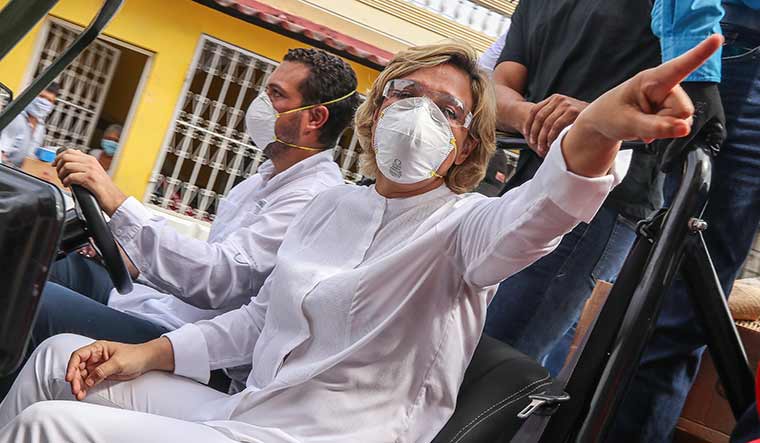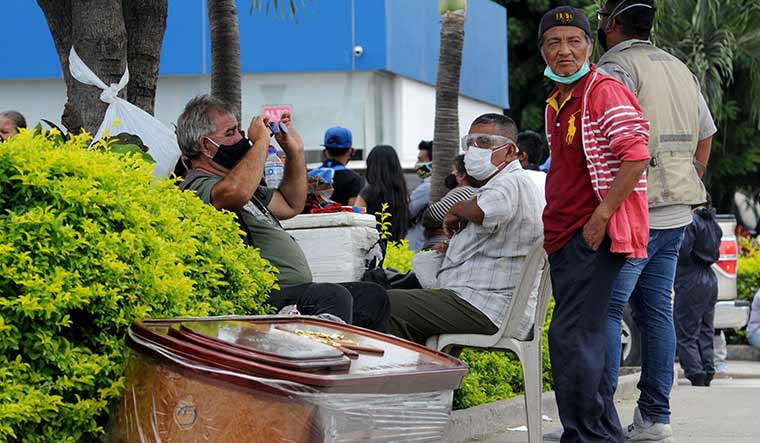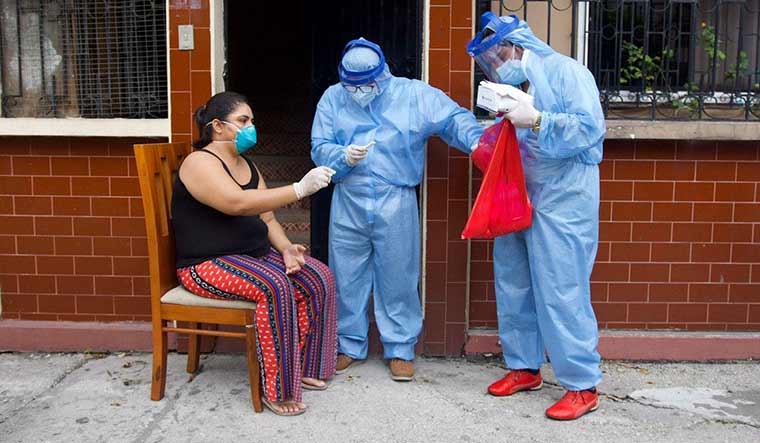Covid-19 has taken more territory and broken more defences across the planet than Genghis Khan, Attila and Alexander the Great combined, and it looms over humanity with a menace that appears to leave no refuge. At the current rate of doubling of casualties, the world could see some 36 million deaths in a year, and over 140 million dead just four months later. In this world war, humanity is fighting to survive and dominate a strand of DNA that itself is hard-coded to survive and dominate. The battles fought in this war are a record of reference for the rest of humanity.
“The war on Covid-19 cannot be fought in the emergency rooms and ICUs but in its breeding grounds—in the homes and neighbourhoods,” says Guayaquil Mayor Cynthia Viteri. “You have to take from it the element of surprise. Using the knowledge that you develop, you avoid open battle in the hospitals, you launch raids and surprise the virus in the zones and barrios where it is beginning to gain ground.” The Ecuadorian city of three million was the earliest example of Covid-19 horror in the Americas. Now, it deserves another title: The city that beat back Covid-19.
Viteri knows well that waves of aftershock might come, yet she is focusing on the takeaways from what has already happened and why it happened when the city was at its lowest moment—deaths in one day—and how it turned the tide, reaching a zero-death toll in just 34 days.
As Covid-19 stormed through her city, Viteri was in quarantine along with her husband and son—the three of them had tested positive for Covid-19. At a time when there was no clear playbook and the central government was not able to provide health and sanitation services, she began a campaign that relied on a public-private voluntary effort and top-down implementation and leadership. By increasing the city’s hospital, ICU and direct piped-in oxygen-delivery capacity in record time and by addressing the funeral, morgue and cemetery shortages, Viteri delivered the services her city needed and her county was unable to provide.
Additional help came from the city’s former mayor and two-time presidential candidate, Jaime Nebot, who lent his skill and connections to set up an emergency committee to secure early-treatment medicines through a global acquisition effort. His efforts procured PPEs and later helped rework food supply chains. “The goal was to ensure populations did not have to mix with large groups far from their homes to acquire food,”he said, and that “people did not have to choose between dying of hunger vs dying of coronavirus.”
Viteri and Nebot then focused on hunting the virus through door-to-door visits to thousands of homes every week, providing sanitation, disinfection, pest-control, food and medicines. Those presenting symptoms were given treatment and kept in quarantine at home; when a home was not adequate for quarantine, an ambulance took them to one of the newly outfitted hospitals.
“People knew they would be in a good place, with good medical attention, good care, oxygen, food, and that they would not be cut off from their families,” says Viteri. A weekly survey of homes with sample-population testing helped identify hot spots and allowed the city to respond quickly to the area and cut-off any foothold the virus may be gaining. To ensure there were enough doctors and nurses, Viteri says “the city provided hotel rooms for health care workers brought in to supplement the hospitals, and for those who wanted to remain isolated from their families”.
As streets that once thronged with life stood empty, fully equipped teams walked the cracked sidewalks daily with one tense purpose—to ensure that the virus had no place to hide. The city delivered more than one million food kits to help keep people at home. It hired some 200 women to sew masks to outfit those who could not afford one.
During the same time, the city launched a telemedicine platform for those who could not attend to their medical appointments because of Covid-19, and for those suffering stress and mental illness as well as for those with addiction problems. This service, run through the city website, allows the continued employment of doctors in risk categories and begins with a symptoms evaluation of callers to screen for Covid-19.
The city also embraced the use of SOSAFE, a citizen participation smart-city app, to establish a direct channel of communication with all levels of the municipality. From their phones, free of cost, citizens can contact city departments from telemedicine, health services, to trash pick-up, to police and fire services.
There have been no deaths for 36 days since May 10 as of the date of this interview. Though many early steps can be criticised, it was textbook crisis leadership. Viteri and her city, the civic leaders, the former mayor, the emergency committee, the doctors, the front-line workers, the brigades, and the people have together beat back the pandemic in Guayaquil.
Despite that, its citizens are defeated, says Guayaquil-based sociologist Cesar Aizaga-Castro. “There is no optimism; there is conformism,”he says. As Guayaquil got infected and the authorities were not in a capacity to intervene in a direct manner, people felt they were without a government, without support, and lacking all the capacity to mount a fight, says Aizaga-Castro.
The media did not have accurate information, people suspected they were hiding information, he says. “Lack of hospitals, lack of the necessary equipment. In a matter of weeks, you could see bodies in the streets. People died and died,” he says.
People realised there was total chaos, and at that time lost all confidence in the media, says Aizaga-Castro. “People did not follow the quarantine, they went out because they had to,” he says. “They lived of what they sold, their little businesses. The country did not have a structure of authority to handle the situation.” That is when the local government decided to take control, he says.
At first, city hall did not make the case for staying at home, says Aizaga-Castro. Soon, most people realised that everyone had a family member affected, that there was contamination in places like markets. “There were people who had someone sick at home but did not go out to seek help because they knew that going out meant being exposed and getting sick,” he says. “There was shock and great anguish because you knew your neighbours had died. We could see this happening, and wondered who could save us.”
Many people went into hospitals and their relatives never even saw their bodies again. Parents were saying goodbye to their children, and telling them it would be ok if they were incinerated, says Aizaga-Castro. “You could see common graves, you looked up and could see vultures circling over the hospitals,” he says. “Guayaquil smelled of death.”
Guayaquil attorney José Chiriboga-Hungría says the reaction of the national government was late, and that even the minister of health resigned during the height of the onslaught saying the government had not released sufficient money to face the pandemic. Facing the abyss, people even questioned Viteri’s Covid-19 infection, notes Chiriboga-Hungría. “People died in hospitals or in their homes, the bodies laid there for three to seven days without burial,” he says. “Cemeteries were not ready to receive so many dead. People chose to take their deceased relatives (out) to the streets to ward off the smells and contagion.” That is what the world saw on its TV screens.
“In hospitals, the bodies of the deceased rested in containers, some without identification…,” says Chiriboga-Hungría. “And, around this there was much corruption…where certain people charged the relatives of the deceased, to be able to help identify the bodies.”
Yet, the saddest thing was that due to restrictions, says Chiriboga-Hungría, “many Guayaquileños could not say goodbye to their loved ones; others, to this day, have not found their relatives’ bodies.”
Why? Why? Why? Why?
Por que? Por que? Por que? Por que? The mayor recognised the voice of her neighbour lamenting the death of a loved one. As she quarantined at home with her family, Viteri felt the grief pierce through her in a way that forms a knot in her throat even today. Death was everywhere. It was heartache that went on and on, she says. “It was confusion—a sea convulsing with more confusion,” says Viteri of her time at home in isolation. Asked to recall those moments, Viteri closes her eyes and visualises herself in the middle of waves as great as mountains that come from every direction—with every statistic, with every wail of an ambulance, with every death report. “And I am in one of those waves, and I need to—with my team, with the military, with the police, with all who help me—go and wrestle life from death,” says Viteri. And, she did that.
Covid-19 had crushed the medical system, the funeral system, the morgues; in hospitals, people had to walk past wrapped bodies without even knowing who was inside, recounts the mayor. “Those were the worst days of my life,” she says.
The city’s worst day was many days, adds Viteri. Guayaquil was a city in turmoil, its local government overwhelmed, a national government absent, people agitated, a hectic chaos in the street, public workers irate, exhausted resources, food scarce, general despair, and no clear way forward. “Suddenly, there was nothing certain and the population lost total confidence. The country did not have corresponding authorities to manage the situation,” says Aizaga-Castro.
This is when Viteri stopped looking for help elsewhere and took charge. Structurally, she did not have all the authority, says Viteri. As dictated by the country’s constitution, the entirety of the health and sanitation systems come under the jurisdiction of the national government, leaving the city in charge of water, sewer, trash, transportation, markets and the like. But that would no longer matter. She would assume the responsibilities in front of her and take charge of rebuilding the collapsed health, funeral, morgue and cemetery systems.
Leadership and strategy
With taking charge came clarity of purpose and Viteri boiled down her mission to two simple problems: save lives and feed the people. The strategy: coordination and discipline. Guayaquil was lucky it could rely on the emergency committee to generate strategies to reverse the crisis. The committee included Viteri, business titans, doctors, pharmaceutical executives, health professionals, farmers and members of civil society. If this was war, this would be the city’s counterattack.
Focused on her two-pronged war strategy, Viteri set out to marshal money and assistance, commandeering the yearly budgets of the city’s departments, including those for public works destined to commemorate the city’s 200th anniversary, and taking on responsibilities beyond her mayoral powers. To save lives, Viteri’s team began to look at death as one of three tactical areas: attending to the dead, epidemiologic control and attending to those alive. Each tactic engendered its own strategies.
The city moved to take care of the bodies in the streets and in homes. Viteri moved to address the shortage of funeral homes, morgues and cemeteries by securing freezer trucks outside hospitals, building cemeteries and contracting a company to pick up bodies. In its first week, it collected 500 bodies off the streets.
To attack the pandemic, the city hired hundreds of doctors and medical personnel, spread them in satellite medical tents so that people would not have to go into the high-concentration areas of the city and risk infection. Viteri also set up free-of-cost birthing clinics so expectant mothers could give birth without fear of exposure. Then came what she considers the coup de grace—the deployment of medical teams going door-to-door to find the virus. This entails visits by special brigades to homes to evaluate early symptoms and get immediate attention to those in need so they would not worsen and arrive at the hospitals too late. “We are chasing the virus,” says Viteri. “Instead of it chasing us.”
To get this done required work on several parallel tracks. It began with outfitting 51 health centres, field hospitals, outreach tents in peripheral areas, hiring some 500 doctors, adding 25 ambulances, turning the convention centre into a hospital and finishing an abandoned construction project for a second hospital with 300 beds. When it was clear oxygen supply would be a problem, the city set up an oxygen-generating plant to supply piped-in oxygen to hospitals and to stem the speculation that had inflated the cost of an oxygen tank from $50 to $1,500.
While governments from Washington to Buenos Aires to La Paz were frantically purchasing ventilators, Guayaquil noticed that half of the patients on ventilators were dying, so they focused on treating people before they needed to be intubated. To that end, the effort focused on purchasing medicines for early-stage treatment and on keeping people off the streets to avoid infection. For the quarantine to work, Viteri wanted to make sure her people were fed. Ensuring food entailed a shortening the supply chain, cutting out middlemen and supplying neighbourhood stores directly.
Prevent. Treat. Avoid death. To build that wall of defence, the cornerstone would be quarantine. To prevent the strategy from collapsing upon itself, the emergency committee set out to address the social impact of staying home without an income.
Guayaquil re-engineered supply chains with substantial participation from the private sector. Cerveceria Nacional, the country’s largest brewery, led a group of other companies in the logistics battle. To stop price speculation, they began by supplying nearly 5,000 neighbourhood stores. Donations from farmers provided some 1.5 lakh fruit deliveries to the neediest neighbourhoods.
Eventually, in-home visits delivered one million food reserves, vitamins, supplements, even diapers, at the same time disinfecting, fumigating homes, leaving disinfecting kits, chlorine and some 1.4 lakh food kits to 5,000 families each week.
It is an elaborate campaign to effectively chase the virus, and effective follow-up is necessary. Viteri describes the work with a statistical survey group that samples 1,600 homes across 17 districts of the city, identifying where the virus is so that efforts can be concentrated there to put down any spike. Teams are there the next week. Nobody is waiting to be surprised.
This is all built on a monumental effort that was mounted to outfit, retrofit, and supply all hospitals for the central government as well as all clinics, public and private. They were all stocked, free of charge, with a cocktail of drugs for early treatment.
Medicine acquisition was undertaken by a team of the country’s top private sector leaders—pharmaceutical executives, buyers, importers, custom-clearing specialists—who fanned their efforts across Europe, Latin America and China. The team worked for free, says Nebo.
“Dos prioridades (two priorities),” repeated Viteri. “People did not want to go to public hospitals. They were afraid,” and with good reason, says Viteri. “They would go into the hospital and they would not come out, even when they died,” referring to the corruption that extended to making bodies “disappear” only to be found for a fee.
“People lived the tragedy in their own homes, only seeking help when they turned gravely ill, often too late,” says Viteri. “We changed the strategy, we went out to find them before, at early onset and intermediate stages to get them immediate treatment to avoid complications so they could be saved.” At the time of writing this story, they had assisted 1,02,573 patients who never went to a health centre, and there had been 36 days of zero deaths.
“But our vigilance continues,” says the mayor.
Viteri’s arsenal relies on the telemedicine initiative so that people can keep up with non-Covid-19 related medical care while keeping them off the streets and providing doctors in vulnerable groups a way to continue to work while helping the war effort.
In the post-mortem as to how and why Guayaquil ended up as one of the hardest-hit cities in the world, the start of community spread is placed by experts on a March 4 soccer game for the Copa Libertadores that had about 20,000 spectators.
“It resulted in massive contagion which led to the saturation of hospitals, institutions that collapsed and couldn’t handle the number who came for help; besides, they didn’t have enough equipment to fight the contagion,” says Chiriboga-Hungría. “The reaction of the national government was late.” He also calls out Viteri for a late response and controversial missteps early on.
In the end, the battle plan has succeeded, and there is one takeaway of global import: it is essential to control the element of surprise by surprising the virus in early stages. It is the one thing Viteri wishes she had known before all of this started.
What about the city’s 200th anniversary later this year? It will be marked with a memorial to the 10,000 dead, says Viteri.
The city’s response to Covid-19 was not perfect. But during the battle there emerged a healthy respect for what the virus can do, and a steely willingness to do anything it takes to defeat it. The mayor is not declaring mission accomplished. Vigilance, she says. “Every day.” She says she will never stop.
“Vigilance,” she says, again. “Unwavering.”
She looks up.




